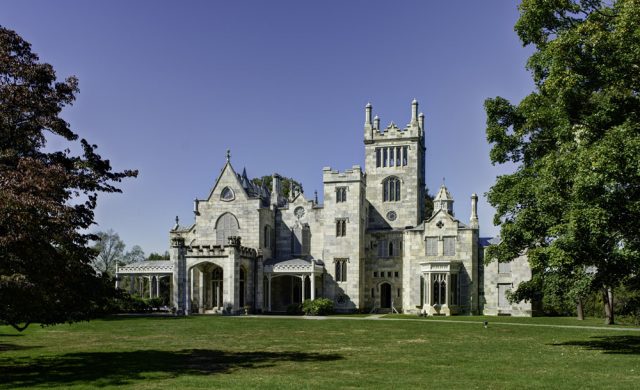Lyndhurst Mansion
635 South Broadway
Tarrytown, NY 10591
Tel.: 914-631-4481
E–mail: Lyndhurst@savingplaces.org
URL: Lyndhurst Mansion
![]()
Overlooking the Hudson River in Tarrytown, New York, is Lyndhurst, one of America’s finest Gothic Revival mansions. Designed in 1838 by Alexander Jackson Davis, its architectural brilliance is complemented by the park-like landscape of the estate and a comprehensive collection of original decorative arts. Its noteworthy occupants included: former New York City mayor William Paulding, merchant George Merritt, and railroad tycoon Jay Gould.
William Paulding
The estate was shaped during more than a century by these three families. Their influence is evident in the expansion of the main house from a country villa “in the pointed style” to a Gothic mansion, as well as in the rich furnishings and in the park-like design of the grounds.
The 19th century was a period of political and technological change in America. Romanticism dominated the arts, and as the movement emphasized the appreciation of nature, imagination, and emotion, the Hudson River Valley became the center of painting and architecture. Wealthy patrons commissioned the construction of mansions in a variety of styles along the bluffs of the river from New York City to Albany.
Lyndhurst was first conceived in the minds of architect A.J. Davis and William Paulding who constructed the country villa in 1838 and called it “Knoll”. The romantic Gothic Revival design immediately drew attention to the building. Critics called it “Paulding’s Folly” because its fanciful turrets and asymmetrical outline were unlike most homes constructed in the post-colonial era.
George Merritt
Fascination with the property continued for decades. As ideas of wealth and status changed with the growing nation, so did the estate, reflecting the tastes and interests of wealthy New York.
In 1864-1865, Davis doubled the size of the mansion for the second owner, New York merchant George Merritt, who renamed it “Lyndenhurst” after the Linden trees that were planted on the estate.
Jay Gould
Railroad magnate Jay Gould purchased the estate as a summer home in 1880, seven years after Merritt died. By 1884 Jay Gould had gained control of Western Union Telegraph, the New York Elevated Railway and the Union Pacific Railroad. Mr. Gould used Lyndhurst as an escape from the pressures of his business life. When his health was impaired by tuberculosis, Lyndhurst served as a country retreat until his death in 1892.
Helen Gould
Jay Gould’s eldest daughter, Helen, who later married Finley J. Shepard, was given charge of the property upon her father’s death. She was involved in numerous philanthropic works during her lifetime. When she built the bowling pavilion and recreation center at Lyndhurst in 1894, she included in it a dedicated space for a sewing school that taught local woman a trade that would allow them to move out of service and into their own homes.
Anna, Duchess of Talleyrand-Perigord
After her sister’s death in 1938, Helen’s younger sister, Anna, Duchess of Talleyrand-Perigord, returned from France. While she lived primarily at the Plaza Hotel in New York City, she maintained Lyndhurst as a country home. After World War II, Anna allowed soldiers to convalesce at Lyndhurst. When Anna passed away in 1961, she bequeathed the 67-acre estate to the National Trust for Historic Preservation.
Today
Lyndhurst’s vast collection of art, antiques, and furniture have remained largely intact due to the mansion’s use primarily as a country residence. In most instances, the furnishings are original to the house, and more than fifty pieces were designed by the architect himself, Alexander Jackson Davis. The arrangement of the rooms reflects the lives of one of the three major families and the five major owners that lived here. As such, the mansion reflects the development of American identity and taste during the 19th and early 20th centuries.
The grounds at Lyndhurst survive as an outstanding example of 19th-century landscape design. Elements include sweeping lawns accented with shrubs and specimen trees, the curving entrance drive revealing “surprise” views, the angular repetition of the Gothic roofline in the evergreens, and the nation’s first steel-framed conservatory. The rose garden and fernery are later additions.
















